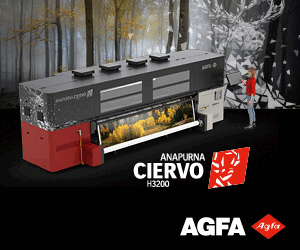Clive Mitchell from Walsall College sums up this topic: “It is ironic that we are in the business of promoting other industries, but we do not do enough to promote our own!”
With technology and the means of communication developing at dizzying rates, the world of business is more fast-paced than ever. When it comes to visual communications, the means of delivery are at the cutting edge of innovation, so are we doing enough to communicate this to the next generation?
There are encouraging signs of improvement as more efforts are being made by enlightened employers, industry associations, education establishments and recruiters to engage and entice the younger generation – but is it enough?

The FESPA UK Next Generation Project
Suzi Ward, Managing Director of the FESPA UK Association, says the industry needs to do more, and FESPA UK is playing its part to help, “We are a vibrant and modern industry, with a wealth of career opportunities to suit everyone’s interests and academic levels. There are careers for every type of person in our industry, from school leaver apprenticeships to university degree graduates. Still, as an industry, we need to do more to show what the options are to ensure young people notice us and understand the opportunities.”
To support this important area, FESPA UK has created the Next Generation project. “Our Next Generation Committee is a group of enthusiastic, proactive young people working in print and signage. They are headed up by our own rising star Jay Burfield, and they shadow the FESPA UK Board and help us to see things from a younger perspective. We are aiming to empower young people who already work in print and signage and show them the benefits of networking and building valuable working relationships within the industry. The aim is to build their self-confidence and value within the company.”
She continues, “The long-term goal with this project is that by working with the Next Generation project committee and other young people from the industry, we can use their ideas, content and methods of sharing content to reach people outside the industry and highlight this exciting world we are all so passionate about.”
FESPA UK is working alongside other associations like the Textile Centre of Excellence and businesses like Make It Happen Signage Consultancy, which offers fantastic training courses.
Sam Armstrong, founder of Make it Happen, says, “As an organisation, we are here to help people and businesses to be more successful at selling, specifying and delivering signage solutions. There isn’t a public-facing business anywhere that doesn’t have a need for some form of signage, and the choice of options is mind-blowing. This is why it is so important for professionals within the industry to have as much understanding as possible about what their clients are really looking for. They are signage consultants – delivering solutions, not just signs – and we aim to work alongside them in lots of different ways to help them succeed.”
She continues, “While there is no substitute for experience, we also recognise that knowledge, expertise and confidence are equally important. This is why we are always encouraging our sign-making clients to send their younger staff to our training sessions. They are the real future of our industry, and there is so much for them to learn, and we want them to be the very best they can be right from the off. We always have at least one or two younger people at our sessions, and their input is often relevant, insightful and important. Their fresh perspective is exactly what is needed, and we are delighted to play our part in educating the super sign-makers of the future.”
“By encouraging the young people in our Next Generation project, we are highlighting the industry to people looking for career opportunities outside the industry. We are mainly using social media and are looking to work more closely with further education providers and schools,” says Suzi.

FESPA UK’s Next Generation Roadshow starts at Liyu UK’s Burscough showroom on July 12th
Roadshow of FESPA UK educational events for the Next Generation
She adds, “The FESPA UK team has arranged events around the country for the Next Generation project. We have 3 events planned for small groups of 10 at a time, as we feel that is a manageable number for people to interact and learn within a members’ facility. Our first one is in the North of England on 12th July at Liyu UK’s new showroom. We have a social media and marketing expert doing a workshop in the morning to help younger people already working in print understand the key areas where digital marketing can effectively support the businesses they work within. In the afternoon, there will be a hands-on interactive session where the attendees get to use the latest technology to design and print their own work, following the process from concept to print finishing. This is aimed at giving them a good idea about what other roles within their business could look like.”

Social media and digital marketing are the focus for the next session
FESPA UK will also be at the Print Show, where four of their Next Generation committee members and FESPA UK’s own Jay Burfield will speak in public on a panel discussion within the exhibition. “The aim of this it to help to build confidence with public speaking and also increase their networking opportunities,” says Suzi.
The next session will be in the south at Zund UK’s premises in October. Here a small group will be looking at workflow and how it helps to support print and signage businesses. There will again be a speaker workshop in the morning, followed by a hands-on session in the afternoon.
The major issues holding back the print and sign industry are the perception gaps and the misconceptions that deter young people from pursuing careers. “The biggest problem is we are not recognised as a viable industry,” says Suzi, “Younger people see us as old-fashioned, factory-type work, and I don’t think people outside print and signage have any idea what careers are available. Very rarely is print or signage mentioned in career days or sessions at school. It’s such a shame because we are one of those rare industries that touch almost every part of everyday life. Everywhere you look, most things you touch, every hobby or concert or night out has a print or signage element to it. We need to highlight what the world would be without our industry to really make people understand why they should be part of it.”
Businesses need to play their part
Matt Hanley from Matching Talent with Opportunity adds, “The industry is definitely getting much better than it has been, but there’s so much more to be done. You have movements like FESPA UK’s Next Generation Project and incredible businesses like Learn2Print, but the onus has to be on business owners. We need more examples of how young people’s successes in the industry in order to educate other “archaic” businesses to embrace the next generation.”
He continues, “Good people know good people. Getting the next generation into the print world has to start with them being ‘good’ people. The right work ethic, morals, desire to learn etc. What else can you base the potential on? These good people will typically know other good people. Incentivise them to refer a friend. Macroart are brilliant at this, as are RMC. Macroart held an open day for local schools and colleges earlier this year to show them what potential there is within print. Once you’ve seen the size and scale of what can be done, it changes the whole appeal.”
In terms of opportunities, Matt says getting to know all aspects of the business is everything, “I’ve had the experience of recruiting graduates and trainee people into businesses, and the ones that I have seen flourish are ones that spend several weeks in different departments and then pitch for a job in the department of choice. It creates a solid awareness of what each department does. It helps hone their skills and focus, but also cements their interest in the business as they feel part of all the teams.”
Matt also puts a good word in for the industry, “I think it’s a misconception that print and signage is an old and dying industry. Actually, it couldn’t be further from the truth. Although, I suppose, being in it, we would say that! I think it’s for owners or senior leadership teams to be open-minded and offer the ability to develop and adapt to young people. Give them the appropriate amount of responsibility to drive change and transform your business.”
ISA-UK encourages greater collaboration
Craig Brown, CEO of the International Sign Association UK (ISA-UK), agrees with others but is very much of the belief that the industry needs to work together to help encourage more young people. “As an industry, we tend to be reactive rather than proactive. That’s not unusual. We certainly aren’t the only sector that isn’t seeing enough young blood coming into their industry fast enough to replace those that retire or leave it. I really think that more industry bodies should come together within the education sector to create content that youngsters would find interesting.”
Craig thinks a modern take on ‘show and tell’ would have a very positive effect. “You have to make the industry look as attractive as possible for young people. I have done things like this in the past where schools have, for example, run a Dragons Den day where they invite local business owners in to critique ideas. It’s a simple idea, but very effective with young people and incredibly engaging.”

We have to make the industry look as attractive as possible for young people
He adds, “ISA-UK has been involved with developing the content and syllabus for both NVQs and modern apprenticeships for quite some time now and have been in an ideal position to feedback the wishes of the business community. Hopefully by working with both the colleges and businesses, we are in a great position to get feedback along with constructive input on how the courses can be kept relevant to all parties.”
The ISA-UK has long been committed to the important role of education and apprenticeships in the industry. Craig explains, “We have worked with Walsall College for many years, delivering presentations to their students throughout the academic year. We also now have a member of the board who has qualified as an end-point assessor for students going through the NVQ and apprenticeship process. We have also been approached to go into the IfATE Employer Directory – an industry expert guide for the modern apprenticeship.”
He continues, “If young people can see a clear career path within a business, the industry would be much better able to sell itself. Unfortunately, small businesses are often reluctant to do that when staff loyalty is seen as a problem. I guess if we can fix one, the other will cure itself!”
As well as Walsall College’s well-subscribed apprenticeship programme, Craig mentions the BPIF’s in-house, OFSTED-regulated training programme. “We are always happy to connect the right people to each other. We want the ISA-UK to be used as a conduit to share information. We are there to support the industry, and we actively encourage both the industry and the education sector to share collateral. People coming together and working in unison, rather than individuals banging a drum in isolation, is the only way we can change for the better.”
View on Apprenticeships from Walsall College
Clive Mitchell is a Vocational Coach in Sign-making at Walsall College and he told us, “The sign and print industry could do more to encourage young people into the industry. However, the industry needs more collaboration with educational institutions such as schools and colleges and maybe other industries. The sign and print industry is huge, probably bigger today than it’s ever been, but nobody seems to know what we do. We can educate the people that are already in the industry with NVQs and Apprenticeship Standards, but it’s the people outside of the industry that need educating so they understand the opportunities for young people.”

Walsall College offers the Level 3 Signage Technician Apprenticeship, which is fully government-funded up to the age of 19 and part funded for 19+
Walsall College offers the Level 3 Signage Technician Apprenticeship, which is fully government-funded up to the age of 19 and part funded for 19+. This is aimed at newcomers into the industry and NVQs levels 2 and 3 for experienced workers. Unfortunately, the way the system works means that youngsters have to have a contract of employment before they can be signed up for a formal apprenticeship.
“There are very few training providers offering apprenticeships, which means the majority of learning is conducted online, with the practical teaching left to the employer. As the industry is made up of SMEs, not all learners are getting the proper training because employers do not always have the time to give. Also, practical training is not standardised as employers will teach them different things. This leads to learners becoming disillusioned and, consequently, poor retention in the industry,” says Clive.
“Make it Happen Signage Consultancy runs excellent short courses, and the College have good links with Sam and her team. Unfortunately, as the courses are not government funded, we have difficulty offering these as part of the Apprenticeship,” he adds.
“I believe the way forward is for more collaboration with schools and 6th form colleges to promote the pathways available and not just to pass the sign and print industry off as ‘something you can do if you fail everything else’. Perhaps a nice glossy brochure at careers events could be produced? A national event promoting the skills that can be learned, with demonstrations rather than a sales pitch from suppliers? Sign and Digital UK would be an ideal place for these demonstrations, but the educational establishments need to know about these because otherwise, only people in the industry will attend. This is not the audience we are aiming at.”
He continues, “I suppose it all comes down to finance in the end. Education needs more money and is clearly not going to get it from the government. This means there has to be input from the industry, building lasting partnerships up and down the country.”
It is not all doom and gloom and Walsall College has plenty of success stories. “We have had apprentices that have completed their studies and are now running their own businesses or are climbing the ladder in their respective companies.”
“The sign and print industry is a dynamic industry with great opportunities for young people to gain practical experience with some of the latest technology available while still using traditional skills and being able to mix the two. It is ironic that we are in the business of promoting other industries, but we do not do enough to promote our own!” concludes Clive.
And that’s where we came in. In part two of this feature, we will talk to some businesses about what they are doing. Many thanks to everyone who took part.
Please message me on jack@eyeondisplay.co.uk with you comments on this feature and if you would like to contribute to future articles.






















